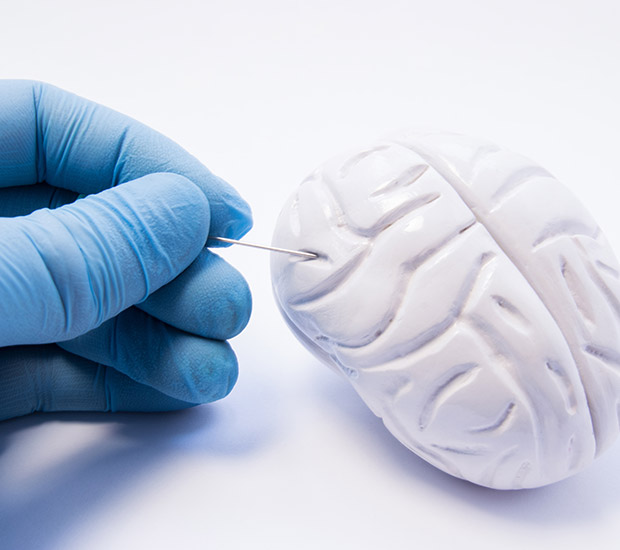MeningiomaPhoenix, AZ
For many patients, meningioma treatment can make the difference between life and death. While most of these tumors are benign, they still require professional monitoring. Meningioma treatment may involve observation, surgery, therapy, and medication.
Meningioma treatment is available at Randall Porter, M.D., in Phoenix and the surrounding area. Do not let fear take over your life. Call us today at 602-603-8951 to schedule an appointment or learn more about our services.
Understanding Meningioma
Meningiomas are a type of tumor that develops on the membranes covering the brain and spinal cord. They grow on the three layers of membranes, also known as meninges. As such, there are three grades of meningioma. Grade 1 meningiomas are the most common type of meningiomas.
Meningiomas are also the most common type of tumor originating from the central nervous system overall. Most grow slowly, and up to 90% are benign. They typically develop in the brain, though they may also affect parts of the spinal cord. Still, even benign meningiomas can cause severe — sometimes even fatal — complications.
Signs of Meningioma
It is not uncommon for patients with meningiomas to have asymptomatic cases that do not require immediate treatment. When symptoms do occur, they tend to begin gradually and subtly. These may include:
- Changes in vision
- Headaches, particularly those worse in the morning
- Hearing loss or ringing in the ears
- Loss of smell
- Memory loss
- Newfound language difficulty
- Seizures
- Weakness in the arms or legs
- Vision changes
It is essential to note that the above symptoms are not exhaustive. Furthermore, symptoms may vary depending on the exact location of the tumor. Patients should always contact a doctor as soon as they notice any signs of meningiomas, but especially if they begin experiencing a sudden onset of seizures or sudden changes in vision or memory.
Causes of Meningioma
Experts have yet to know what exactly causes a meningioma, but it is clear that it involves something altering the cells in the meninges. This eventually makes them multiply out of control, creating a meningioma. It is unknown what causes this cell mutation to happen. However, some things may raise one’s risk of developing a meningioma. These include:
- Female hormones
- Inherited nervous system disorders
- Obesity
- Previous radiation exposure to the head
Women tend to have meningiomas more frequently than men, leading experts to believe progesterone may play a role. Some studies have also found there may be a relationship between breast cancer and meningioma. Meningiomas are also more common in obese patients, those with neurofibromatosis 2, and radiation exposure to the head — though the nature of these relationships is not evident.
Diagnosing Meningioma
According to the Mayo Clinic, meningioma diagnosis almost always occurs after the patient begins to show symptoms. Meningiomas may also be challenging to diagnose, as they tend to be slow-growing. Plus, symptoms are often mistaken for signs of other health conditions — or merely taken as expected signs of aging.
Once a patient’s primary care physician suspects they may have a meningioma, they will refer them to a neurologist for an official diagnosis. This visit will involve a thorough neurological exam and an imaging test utilizing contrast dye. These tests may include computerized tomography (CT) scans or magnetic resonance imaging (MRI) scans.
CT scans use X-rays to create a full image of the brain, while MRI scans use a magnetic field and radio waves to develop cross-sectional pictures of the brain’s structures. Typically, MRI scans will provide the most detailed information on the brain and any meningiomas present.
Treating Meningioma
As mentioned earlier, many meningioma patients do not experience any symptoms. However, as stated by WebMD, observation is still recommended in many cases of asymptomatic meningioma. Regular brain scans can ensure that the tumor does not continue to grow or, if it does, let the neurologist and patient know ahead of time which steps to take.
If the patient begins to develop symptoms, they may need surgery — typically a craniotomy, which involves removing some bone from the skull to access the brain for the neurosurgeon to remove the tumor. Afterward, Dr. Porter will replace the removed bone. However, if the tumor is not accessible via surgery, radiation therapy may be necessary. While rarely used for meningioma treatment, chemotherapy can also help treat cases that are resistant to both surgery and radiation.
Call Us Today
Having a meningioma can be a frightening, life-threatening experience. We at Randall Porter, M.D., can help. Call us today at 602-603-8951 to schedule an appointment or learn more about our services.
Frequently Asked Questions
What is an atypical meningioma?
Atypical meningiomas are neither benign nor malignant (also known as cancerous). However, they have the potential to turn malignant. Unlike benign meningiomas, cancerous meningiomas tend to grow quickly and spread to the lungs and other parts of the brain.
Are biopsies ever used to diagnose a meningioma?
Sometimes. During a biopsy, Dr. Porter will remove part or all of the meningioma to determine whether it is cancerous. He will typically only do this to rule out the possibility of other types of tumors.
What is the best treatment for my meningioma?
The answer depends on a case-by-case basis. Every patient is different. As such, they should all receive the individualized treatment they deserve. Dr. Porter will consider how large your meningioma is, where it is located, how quickly and aggressively it is growing, your age and overall health, and your goals for treatment when planning out your ideal treatment.
What will happen after I get surgery for my meningioma?
Again, it depends. While Dr. Porter will always attempt to remove as much of the tumor as possible, this is not always possible. If your meningioma is too close to too many delicate structures in your brain or spinal cord, then parts of it may remain. Sometimes, the surgery will still be sufficient. If the tumor is no longer visible, then you will not require any further treatment (though you will need to have follow-up scans periodically). If your tumor was benign and a small piece remains, you may also require periodic follow-up scans. You may also benefit from radiosurgery. If you have an atypical or malignant tumor, you will probably need radiation therapy.
What will radiation therapy do to my meningioma?
Radiation therapy uses a large machine to direct high-powered energy beams at the meningioma cells. The goal is to destroy the cells and reduce the chance of recurrence. There are four main types of radiation therapy: stereotactic radiosurgery (SRS), fractionated stereotactic radiotherapy (SRT), intensity-modulated radiation therapy (IMRT), and proton beam radiation.





